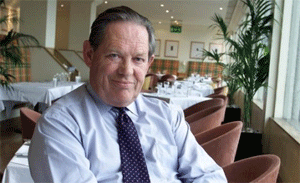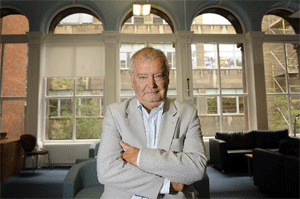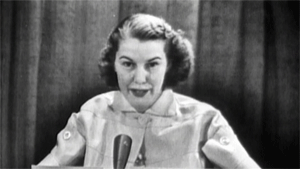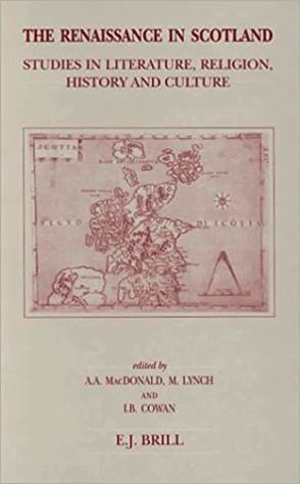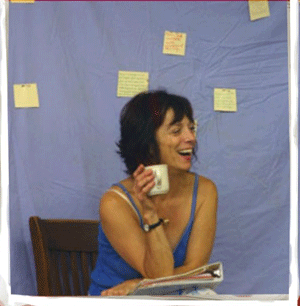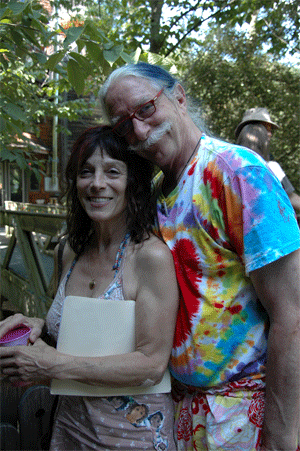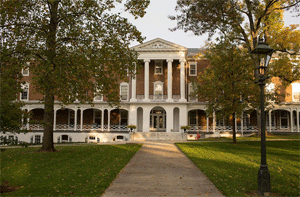FDR Meets Ibn Saudby William A. Eddy
Colonel, U.S. Marine Corps, Retired
First U.S. Minister Plenipotentiary to the Kingdom of Saudi Arabia (1944-1946)
© 1954
NOTICE: THIS WORK MAY BE PROTECTED BY COPYRIGHTYOU ARE REQUIRED TO READ
THE COPYRIGHT NOTICE AT THIS LINK BEFORE YOU READ THE FOLLOWING WORK, THAT IS AVAILABLE SOLELY FOR PRIVATE STUDY, SCHOLARSHIP OR RESEARCH PURSUANT TO 17 U.S.C. SECTION 107 AND 108. IN THE EVENT THAT THE LIBRARY DETERMINES THAT UNLAWFUL COPYING OF THIS WORK HAS OCCURRED, THE LIBRARY HAS THE RIGHT TO BLOCK THE I.P. ADDRESS AT WHICH THE UNLAWFUL COPYING APPEARED TO HAVE OCCURRED. THANK YOU FOR RESPECTING THE RIGHTS OF COPYRIGHT OWNERS.
America-Mideast Educational & Training Services, Inc.
1730 M Street, NW, Suite 1100
Washington, DC 20036-4505
Established in 1951, America-Mideast Educational and Training Services, Inc. (AMIDEAST) is a private, nonprofit organization working to strengthen mutual understanding and cooperation between Americans and the peoples of the Middle East and North Africa.
To Mary Garvin Eddy and Carmen Frances Eddy who cheerfully shared the austerity, anxiety, as well as the adventure of Jidda in wartime.KING IBN SAUDTHE KING OF SAUDI ARABIA, WHO SIGNED HIMSELF “Abdul Aziz Al Saud” but who has come to be known as “Ibn Saud,” was one of the great men of the twentieth century. He won his kingdom and united his people by his personal leadership. He possessed those epic qualities of the leader which Samuel recognized in Saul;* he excelled in the common tasks which all must perform. He was taller, his shoulders were broader, he was a better hunter, a braver warrior, more skillful in wielding a knife whether in personal combat or in skinning a sheep, he excelled in following the tracks of camels and finding his way in the desert. In him his subjects saw their own lives in heroic size, and therefore they made him their king.
For the first time in history he united the Arabian Peninsula, combining its two industries: on the west coast are the holy cities of Mecca and Medina with the annual pilgrimage of the faithful from all over the Muslim world, and on the east coast is the more recent industry of Saudi Arabian oil which has brought the Americans and prosperity. The King was shrewd, self-taught, and very intelligent. His position was that “Allah gave Arabia the true faith and gave the western world the iron,” by which he meant technology and all its fruits -- the telephone, the radio, the airplane, the railroad, and the water pump. Keeping pure what is covered by the Koran -- religion, family life, marriage, education, and Canon Law -- he accepted the “iron,” the technical skills of the West. Able to converse with him as I was in his own language, he often talked with me informally as well as officially from 1944 to 1946. Since then he grew older and feebler, but this is a story of the years before he began to fail.
In those days he was still the very able soldier and shepherd king, feared by his enemies and beloved by his subjects and by his friends.
He has thirty-seven living sons, and daughters whose number is untold. The ladies of the family of a Muslim are a private concern -- not the business of any stranger, nor of the public. The King had, it is said, a total of one hundred twenty-five wives during his life, although there was no queen and no princess. The number of these wives, while it might seem to be merely evidence of capacity for affection, is equally to be explained by the political strategy to unite the tribes of the Arabian Peninsula in allegiance to himself, a royal policy not wholly unknown to Queen Victoria, who scattered her descendants upon the thrones of Europe.
In the winter of 1945 Mrs. Eddy (with our small daughter, Carmen) was the first American lady ever received in audience at court by Ibn Saud, so that it is only in very recent years that there has been any direct contact between our American ladies and the patriarchal court of Arabia.
I. PREPARATIONSBEFORE THE ALLIED LANDING ON THE COAST OF North Africa on November 8, 1942, the handful of us who knew the date and place of the landings were terrified lest we might talk in our sleep. In those days before the landings it was imperative that one neither cancel nor increase normal engagements of any kind lest he give the alert. One must plan to go to the tailor as usual to be measured for a suit, or to a barber for a haircut, or to invite Spanish friends in for a cocktail party which will never come off, just as though nothing were to happen.
We in Jidda were under the same strain in February, 1945.
I had been informed that on his way home from Yalta F.D.R. wanted to meet the King secretly on board a cruiser in the Great Bitter Lake in the Suez Canal, and I was told to arrange for this meeting. Secrecy was of the first importance because of the need to protect the security of Mr. Roosevelt.
We were still at war with Germany, bombs were still being dropped on Cairo and on the Suez Canal, and a target more attractive to German bombers could hardly be imagined than a cruiser with the American President and the Arabian King on board. Until a day or two before the departure for the meeting, there were only five persons in Arabia who knew about the plans: the King; his Foreign Minister, Yusuf Yassin; a coding clerk in the American Legation; and Mrs. Eddy and myself.Several days earlier, the King and his retinue had come from Mecca forty-five miles away to Jidda for the customary annual visit during which the King would meet the officials and notables of the province of Hejaz, receive petitions from his subjects, and distribute charity and food to the poor. A week or so before the date we had announced that the destroyer, U.S.S. MURPHY, would drop anchor in Jidda harbor for a courtesy call during a routine cruise through the Red Sea. This created some comment since no U.S. naval vessel had ever been at Jidda. But the first visit was accepted without any suspicious rumors and the morning before the departure, February 11, 1945, Commodore John S. Keating and Captain B. A. Smith of the MURPHY came ashore to pay their respects to the King and the Jidda palace, to the viceroy of the Hejaz, Amir Faisal, and to the Kaimakam, or Governor, of Jidda. That evening Mrs. Eddy entertained at a buffet dinner on the roof of the Legation the sixteen of the twenty-one ship’s officers who could be given shore leave at the same time, and all the Americans in the vicinity, a total of forty-five -- the largest gathering of Americans in Jidda to date.
The success in keeping the secret in Jidda, where news both true and false travels through the Suq with the speed of light, was really remarkable. Secrecy was aided by the fact that the King had never left Saudi Arabia even to visit neighboring Arab rulers. F.D.R. had assisted in withholding information from the British intelligence by only telling Winston Churchill on the evening before they separated at Yalta of his intention to meet the three rulers of Near Eastern countries: Ibn Saud, King Farouk of Egypt, and Haile Selassie, the Emperor of Ethiopia. Churchill did not like the plan. He burned up the wires to all his diplomats in the area, demanding that appointments with him be made with the same potentates after they had seen F.D.R.
Churchill was thoroughly nettled at the news that the Americans were making a direct approach to these heads of states in an area the British had come to consider a sort of special preserve -- as, indeed, it had been for scores of years. He made it clear that he considered going over the head of the British government uncooperative, especially if no Britisher were to be present to hear the conversation, and was determined to see each of the Kings, as speedily thereafter as possible to preserve the British position.
He did manage to see them all after F.D.R. left, but without necessarily achieving his purpose. Nothing Churchill could say to Farouk would remove his hate for the British. Ibn Saud did not even answer Churchill’s invitation to meet him until he had gotten F.D.R.’s approval, since he was making the trip to meet F.D.R. and did not want to show any discourtesy to his principal host.As for Ibn Saud’s visit with Churchill at Fayoum Lake near Cairo, whether or not it was successful from the British point of view I do not know, but I do know that the King did not enjoy his return trip to Jidda.
The British are said to have told him that whereas the Americans had taken him to the Suez Canal on a destroyer, they were going to return him on a cruiser, H.M.S. AURORA, indicative of the greater prestige of Great Britain. However, the King told me later that his return trip was very dull -- the food was tasteless; there were no demonstrations of armament; no tent was pitched on the deck; the crew did not fraternize with his Arabs; and altogether he preferred the smaller but more friendly U.S. destroyer.To return to the story of the preparations for departure . . . At 3 P.M. on the day of embarkation, February 12, 1945, the King simply and suddenly gave orders at the Jidda palace to break camp and “strike the tents” for the return to Mecca. There was nothing strange about this order since the King normally makes such decisions for immediate execution without advance notice to those about him. He dispatched a telegram in code to the Crown Prince, Amir Saud, in Riyadh, telling him to carry on in his father’s name until further notice. He called his second son, Amir Faisal, told him of his departure, and of its purpose, and instructed Faisal to take complete charge in the Hejaz and to take any measures necessary to keep order in Jidda, Mecca, and elsewhere. He then announced the list of those who were to travel with him in his motorcade to Mecca, entered his car, and gave instructions for the automobiles to drive not to Mecca but directly to the pier at Jidda. There the launches from the MURPHY were waiting, the King and his party embarked; at 4:30 P.M. the MURPHY weighed anchor and started on its journey to Suez. Simultaneously, Jidda was plunged into hysterical commotion.
The rumors which flew about like bolts of lightning cancelled each other out, leaving the people stunned and bewildered. Hashemite enemies with long memories proclaimed that the King had fled his country and deserted his people as King Hussein had fled from Jidda aboard a British warship a generation ago. Others declared at the top of their voices that the King had been kidnapped by the Americans. The only known fact was that he had embarked and gone away. The ladies of the King’s harim (that is, the quota which had accompanied him to Jidda) put on their mourning clothes, put ashes on their heads, and in a solid platoon descended upon the Viceroy, Amir Faisal, weeping and wailing at their abandonment by their protector. Faisal bade them return to their quarters saying, “By Allah, why all this commotion? He told me only an hour ago, and he has left the Kingdom in my charge.” The British colony at Jidda in a cool, well-bred way, was furious at having what Americans would call “a fast one” pulled on them. That night, Mrs. Eddy went alone to a British dinner party -- the invitation to which we had both accepted. She reported that, in spite of the perpetual torrid heat of the Jidda climate, she found at that party an unprecedented frost, with the temperature well below freezing!
II. EMBARKATIONA FEW HOURS BEFORE THE LAUNCHES WITH THE ARAB party came alongside the destroyer, several large dhows also arrived at the ship laden with tons of vegetables, sacks of grain and rice, and one hundred of the best and fattest sheep. In other words, the normal provisions which the King would provide for an extensive sojourn in the desert. He had given orders that everybody on the ship must eat of his bounty, including the American sailors who had come to Saudi Arabia. The Saudi Minister of Finance, Shaikh Abdullah Sulaiman, preceded the King on board ship and told Commodore Keating that all these provisions and the one hundred live sheep must be loaded at once by royal order of His Majesty. The Commodore had quite contrary and standing orders from the U.S. Navy and he was fortunately able to stall until I arrived with the King on the pretext that he did not fully understand what was being asked of him through a very halting interpreter. I was immediately in the middle of a conflict, and I was destined to stay in the middle for a week. I explained to the King that the Commodore had 60-days provisions in the lockers on board, adequate for all. The King replied that this made no difference -- his American guests must eat from his table and from the produce of his country, and particularly they must eat the freshly slaughtered lamb every day. The Navy replied that their lockers also included frozen meat -- more than enough for everybody. The King had not yet, however, had any experience with refrigeration in his country where meat spoils within twenty-four hours and he brushed aside this superstitious proposal that anyone could eat meat sixty days old, insisting that fresh sheep must be slaughtered daily on board. Finally, he had to be told that the sailors would be put in prison if they disobeyed Navy regulations and ate anything except the Navy rations provided for them, and surely he did not wish all of these good sailors to be dishonored for life and imprisoned unnecessarily!
He then compromised, shaking his head over the curious ways of the Unbeliever, but insisted that his Arabs as good Muslims must obey the ceremonial and dietary laws of their own land. No Saudi Muslim ever ate meat more than twenty-four hours old. Commodore Keating, with a couple of dirty looks at me, finally agreed to take seven live sheep on board out of one hundred. As Mrs. Eddy went out in a launch to lunch on the MURPHY, she saw the other ninety-three returning to shore on their dhow, reprieved to live a little longer.
As the MURPHY steamed out of Jidda harbor, to the amazement of the sailors, one of the seven sheep was already being skinned on the fantail of the destroyer.My original instructions from the U.S. Government had been to explain that the party accompanying the King must be limited strictly to four notables and a maximum of eight servants and bodyguards. From the American point of view this was more than adequate, since everything the King might need would be provided for him during his absence. This limitation in numbers was imposed partly by lack of space on a destroyer and partly to facilitate secrecy, since a small party can move less conspicuously than a larger one. I conveyed the invitation with these conditions, but I had also warned our Government to expect the party to double in size before the King embarked, because I knew what competition there would be among the princes and others to accompany the King, and because of the custom of the King of traveling with many attendants in the style of a bedouin chief. In the preliminary conversations Yusuf Yassin had told me confidentially that the party must include a harim for the King, since the King cannot be considered to be traveling in state unless he has accommodations which provide for his family as well as for himself and his men. I was able to kill this, however, by explaining the impossibility of seclusion on board a destroyer whose ladders and companionways must remain open for the passage all day long of able-bodied seamen going about their business of making the ship run. I assured him that the King would not want his ladies trying to navigate the companionways which were very steep and narrow and where a sudden lurch of the ship might throw them off balance and unveil (at least) their faces.
Yusuf Yassin was shocked and disappointed to learn that half the ship could not be curtained off from deck to keel for the King’s private use, but I told him the ship could not run that way and we had to make the best of the available space.
The party of Arabs which embarked finally numbered not twelve, but exactly forty-eight, and would have numbered one hundred if the strongest pressure had not been exerted to keep the party down. For two-thirds of these there were, of course, no accommodations whatever aboard the destroyer. The Commodore’s cabin had been prepared for the King. Three other officers’ cabins were given to the younger brother of the King, Amir Abdullah, his third son, Amir Mohammed, and his sixth son, Amir Mansur, the Minister of Defense. Another cabin was shared by Yusuf Yassin, the Foreign Minister; Adbullah Sulaiman, the Minister of Finance; and Hafiz Wahba, Saudi Minister of State. The rest bunked wherever they could find space -- many sleeping in the gun turrets, wrapped up in their Arab robes in the scuppers, or curled up near the feet of the look-out on the bridge.
Besides those mentioned already,
the party included the King’s private physician, Dr. Pharaon; Bashir Bey Sa’adawi, Privy Councillor, his chamberlain and major domo, Abdul Rahman Tobaishy; the court astrologer, Majid Ibn Khataila; body-guards, coffee-servers (whose splendor of costume contrasted with the King’s own unadorned and unjeweled camel-hair robe), cook, scullions, and slaves. The King did not sleep in the Commodore’s cabin. Bred and raised in the desert, four walls gave him claustrophobia. Canvas was spread over the forecastle deck to convert it into a tent; oriental rugs covered the deck; one of his own chairs, large enough for him to sit in, had been brought aboard, and the King sat on deck and held his Majlis as usual all day long. At prayer times the ship’s navigator would give him the exact compass bearing for Mecca which the King would verify with his astrologer. Facing toward the holy city he would then lead the entire company of Arabs in their prayers.III. THE VOYAGETHE TRIP FROM JIDDA TO SUEZ TOOK TWO NIGHTS and one day. I shall not describe it in detail because the Navy’s story of the days on board the U.S.S. MURPHY has already been told dramatically and colorfully by Captain John S. Keating, in command of the cruise.* The voyage was delightful; the weather for the most part was fine.
The sailors were much more impressed and astonished by the Arabs and their ways than the Arabs were by life on the U.S. destroyer. Neither group had seen anything like their opposites before, but the difference is that any such violent break with tradition is news on board a U.S. destroyer; whereas, wonders and improbable events are easily accepted by the Arab whether they occur in the Arabian Nights or in real life.
The Arab is by nature a fatalist and accepts what comes as a matter of course and as a gift from Allah, all of whose gifts are equally wondrous, undeserved and unexplained. The Arab gets off a camel and climbs into an airplane without any special excitement even though he has skipped all the intervening stages of the horse and buggy and the automobile. Allah gave the camel the proper equipment to walk on the sand and he gave the airplane wings with which to fly like a bird. There is, therefore, no reason to be astonished at the airplane any more than to be astonished that camels can walk or birds fly.The Arabs and the sailors fraternized without words with a success and friendliness which was really astonishing. The sailors showed the Arabs how they did their jobs and even permitted the Arabs to help them; in return the Arabs would permit the sailors to examine their garb and their daggers, and demonstrate by gestures how they are made and for what purposes.
The Arabs were particularly puzzled by the Negro mess-boys on board who, they assumed, must be Arabs and to whom they insisted on speaking Arabic since the only Negroes whom they had ever known were those who had been brought to Arabia as slaves many years ago. With difficulty they were persuaded that these mess-boys were not only American citizens but as much a part of the Navy and of the United States as any of their white shipmates.The first morning after a Negro mess-boy (paradoxically named White) had served the King a very full breakfast of fruit, coffee and eggs without ham, he returned a few minutes later with a plateful of hot pancakes and a jug of syrup. The King smiled and declined, saying that he had his fill and did not wish any more. Yusuf Yassin, sitting nearby, eyed the pancakes hungrily. The King observed this look and said, “Yusuf, you are so fat you need extra food to keep you going. Why don’t you eat these pancakes?” But this was said in Arabic and the mess-boy did not understand that permission had been given. Yusuf Yassin then reached out for the pancakes which White withdrew beyond his reach, saying, “These pancakes are for the King and nobody else can’t have none of them.” When translated this brought considerable amusement from the Arab group at the expense of Yusuf Yassin. White made his exit with the pancakes.
During the trip the King learned to like a number of American dishes which he had never tasted before, although he continued to have his lamb and rice cooked by his own servants. He was particularly fond of our American apples and of apple pie ala mode, and since that time American apple trees have been planted in the Al Kharj agricultural experiment station. The last night on board the King insisted on being host to the twenty-one officers on the ship at an Arab meal with only Arab food served. The entire group sat cross-legged on the deck around the King who was in the best of humor and entertained the company with anecdotes of his battles; to their great delight, describing hand-to-hand combats and showing them one of his fingers broken years ago and still immobilized by a fragment of a Turkish cannon ball.
During the day the King was given a demonstration of anti-aircraft fire at smoke targets, and of depth bombs discharged at targets towed behind the ship. He showed keen interest in all phases of the ship’s armament. He posed willingly for photographs and movie shots of himself with the ship’s officers. After supper and before he retired early, as he always does, a documentary moving picture film was shown on deck before the King and his company.
His favorite was the technicolor film of an airplane carrier entitled “The Fighting Lady,” which he declared to be wonderful, but added, “I doubt whether my people should have moving pictures even like this wonderful film because it would give them an appetite for entertainment which might distract them from their religious duties.” Stories had no doubt reached him of the sinks of iniquity in Cairo where frivolous Hollywood films are very popular.
I said that a good time was had by all on the voyage, but a good time was had by all except me. The matter of movies is a case in point. After the showing of the documentary films on the deck and
after the King had retired for the night, the usual ship’s movies were shown to the crew below decks. This secret leaked to the ears of the King’s third son, Amir Mohammed, who the first morning on board took me aside by the rail and inquired quietly whether I would prefer to be destroyed all at once or to be chopped up in small pieces, bit by bit. I asked him what was the matter, and he said Hollywood picture were being shown below decks and that he was not invited. Abject with terror, I reminded him that his royal father would not approve of any Arab, much less one of his sons, attending these godless exhibitions of half-naked women, and I begged him to forget the matter. He said very little but what he said was emphatic -- to the effect that either he would see these pictures or my children would soon be orphans, and he swore that if I obeyed him he would keep my confidence and not tell his father. To make a long story short, Amir Mohammed and Amir Mansur, his younger brother, were in the front row at the late showing for the crew that night of a movie which featured Lucille Ball loose in a college men’s dormitory late at night, barely surviving escapades in which her dress is ripped off. The film was greeted by whistles and applauding whoops from the crew; an approval fully shared by the two princes. The following repetition of the film was attended by at least twenty-five Arabs. Fortunately, so far as I know news of this orgy never reached the ears of the King.
There were other endless troubles for me, the only link in language and in customs between the 269 Naval personnel and the 48 Saudi Arabs on board. I had a 24-hour job interpreting and mediating; I had to stop Arab servants from making coffee on charcoal burners over the dynamite and re-route sailors who would otherwise pass back and forth in front of Arabs while at their prayers, as no unbeliever should cast his shadow between a praying Muslim and Mecca. I had to keep Arabs out of the engine room and the chart room, and somehow try to locate and round up an Arab who had gotten lost in the ship’s labyrinth at a moment when the King had suddenly asked for him. On one such occasion, just as the sun disappeared below the horizon of the Red Sea and the King was about to lead the Maghrib prayer, he demanded, “Where is Mansur?” but nobody knew. The King told me to find him and produce him. Amir Mansur had gotten lost somewhere, probably mistaking fore for aft, and could not be returned to the forecastle deck until the group prayers were completed. The King was furious. We all stood by very quiet while Mansur went through his devotions twice, fully and correctly.
In prayer there is with the devout Muslim no rank and no front pew. Allah is so omnipotent and man is so insignificant that the differences in rank among men are wholly unimportant and indistinguishable in the sight of God. Therefore, no deviation from his religious duty is permitted to a prince any more than to a slave, and the King made it clear to all that his son enjoyed privileges neither with the Almighty nor with himself.The singleness of belief in an omnipotent God who is so almighty and so remote is illustrated in a Muslim saying which may be translated as follows:
“Whatever concept your mind comes at, I tell you flat, God is not that.”
While illustrating the supremacy of God, this concept is, of course, very far from the Christian idea that God made himself known in human flesh to human beings. No Muslim would think of calling God a “Father” because a father is a purely human concept. The Muslim is offended by Christian use of phrases such as “Son of God” and “Mother of God.”The last morning before debarkation the King gave gifts in accordance with the custom of the desert Arab. To the Commodore and Captain he gave Arab costumes and gold daggers. To each of the other officers he gave Arab costumes and a watch inscribed with the King’s name. Over the loudspeaker it was announced to the entire crew that in appreciation of the many courtesies shown him on board, the King was giving to each Petty Officer fifteen pounds sterling, and to each seaman ten pounds sterling. A sailor standing near me said, “Gosh, Colonel, how much is that in real money?” The Captain made special arrangements later to have a finance officer board the ship at Port Said to change these pounds into dollars for the sailors.
The Commodore and the Captain asked me what they could give the King and I told them that they might give him souvenirs of the trip, particularly some article used regularly on board the destroyer. They gave him gifts of objects which he had already admired: two submachine guns, and a pair of Navy field glasses.It would be difficult to describe the reactions of the sailors to these weird, courteous, and fascinating Arab travelers. It may be illustrated, however, by the alleged experience of the ship’s doctor who, upon arrival alongside the President’s cruiser, the U.S.S. QUINCY, in the Suez Canal, having no further duties for the time being, crossed the gangplank to seek out below decks the Navy doctor on the cruiser who had been detained in sickbay and had not been on deck to witness the approach of the destroyer or the crossing of the Arab party over the gangplank. Glad to relax, and perhaps hoping to impress his superior,
the doctor from the destroyer began to tell something of the experiences of the last two days: the destroyer’s deck, he said, was carpeted with oriental rugs; coffee was cooked regularly over charcoal in the gun-turrets; 7-foot Nubian slaves roamed the ship with clanking scimitars swinging from their belts; live sheep were slaughtered daily on the fantail, etc. The older medical officer from the QUINCY looked at him sharply and said in a kind voice: “How do you find life on a destroyer? Are you sleeping all right? Sure you aren’t under a strain? Here, sit down and have a cigarette and relax.” The doctor from the MURPHY was very indignant; he insisted that his superior medical officer come aboard the destroyer and see with his own eyes this fantasy of East and West which (in spite of Kipling) did meet east of Suez in the strangest economy ever seen on a U.S. naval vessel.
IV. THE MEETINGIn Ancient Rome, Lupercalia, observed February 13–15, was an archaic rite connected to fertility. Lupercalia was a festival local to the city of Rome.
-- Valentine's Day, by Wikipedia
AT 10 A.M. FEBRUARY 14, 1945, IN GREAT BITTER LAKE in the Suez Canal the U.S.S. MURPHY tied up alongside the U.S.S. QUINCY which had taken the President from the United States to Yalta and was to take him back home. The rails of the QUINCY were manned but no salutes were fired as the meeting was to be conducted without alerting the neighborhood. The King, the three princes, and the two ministers crossed the gangplank and went to meet the President who was sitting in his wheelchair on deck. The King and F.D.R. conversed on deck for an hour and a quarter.
After the preliminary greetings the King right away asked the President whether he should accept Churchill’s invitation to see him later -- an invitation which he thought might give the President displeasure, but the President said, “Why not? I always enjoy seeing Mr. Churchill and I’m sure you will like him too.”About 11:30 lunch was announced and Admiral Leahy said to me, “You go down with the King in one elevator to the President’s private messhall, and I’ll bring the President down in the other.” I accompanied the King down to the President’s private suite where he had plenty of time to wash up and several more minutes to spare before the President appeared in his wheelchair.
Admiral Leahy later told me that on the way down in the elevator F.D.R. had pressed the red emergency button which stopped the elevator between decks and smoked two cigarettes. Out of courtesy for the King’s Wahhabi principles the President, a chain smoker, did not smoke at all when he was with the King. The luncheon included, besides the President and the King, the three princes, Yusuf Yassin and Abdullah Sulaiman, Admiral Leahy and Charles Bohlen. Then after lunch all withdrew except the President, the King, Yusuf Yassin, and myself as interpreter, to continue the political conversation until 3:30 P.M.
They were thus together at least five very intense hours.At 3:30 P.M. the Captain of the QUINCY arrived to say that the ship must leave. The King said this was impossible as the President must first come over to the destroyer, his temporary home, to be his guest at an Arab meal; that the establishment of a friendship such as this could not possibly be complete without his entertaining his friend and giving him Arab food. The President explained that much to his regret the movements of the ship and the security clearances for the convoy were inflexible and the schedule must be maintained to the minute. The King seemed very much put out and turning to me he upbraided me violently in Arabic for not having warned him of these arrangements so that earlier in the afternoon he could have acted as host to the President. I told him truthfully that I knew nothing about the convoy’s schedule. The King then said to the president, “Will you at least drink a cup of Arabian coffee?” Orders were given and within a very few minutes the two resplendent coffee-servers, brushing past all of the guards, appeared in the President’s suite and poured cups of Arab coffee for the President and the King. The following day the President told me that no incident had touched him so much as the pleasure which the King showed on serving coffee from Arabia to his new friend. The King and his party took their leave. They had hardly crossed the gangplank to the MURPHY before the QUINCY weighed anchor and was swiftly on its way to Port Said.
The King and the President got along famously together. Among many passages of pleasant conversation I shall choose the King’s statement to the President that the two of them really were twins: (1) they were both of the same age (which was not quite correct); (2) they were both heads of states with grave responsibilities to defend, protect and feed their people; (3) they were both at heart farmers, the President having made quite a hit with the King by emphasizing his rural responsibilities as the squire of Hyde Park and his interest in agriculture; (4) they both bore in their bodies grave physical infirmities -- the President obliged to move in a chair and the King walking with difficulty and unable to climb stairs because of wounds in his legs. With regard to their physical handicaps the President said to the King: “You are luckier than I because you can still walk on your legs and I have to be wheeled wherever I go.” To this the King replied: “No, my friend, you are the more fortunate. Your chair will take you wherever you want to go and you know you will get there. My legs are less reliable and are getting weaker every day.” The President then said, “If you think so highly of this chair I will give you the twin of this chair as I have two on board,” and immediately the order was given and the chair was wheeled across the gangplank to the MURPHY. Whenever the King took friends through his palace at Riyadh, if they were close friends, he showed them his private apartment where his wheelchair rested with the White House tag still on it. The King always said, “This chair is my most precious possession. It is the gift of my great and good friend, President Roosevelt, on whom Allah has had mercy.” The King who later used a wheelchair, did not use this gift chair which was built for the very slight and frail F.D.R. and could never be used by the King, a man of terrific physique and stature.
Throughout this meeting, President Roosevelt was in top form as a charming host, witty conversationalist, with the spark and light in his eyes and that gracious smile which always won people over to him whenever he talked with them as a friend. However, every now and then I would catch him off guard and see his face in repose. It was ashen in color; the lines were deep; the eyes would fade in helpless fatigue. He was living on his nerve. His doctors had told him not to go to Yalta. With Ibn Saud he was at his very best; but he was living on borrowed time, and eight weeks later he was dead.
That night Yusuf Yassin and I, with the aid of Merritt Grant (my colleague from the Legation who had accompanied me with his typewriter), beat out a draft of a Memorandum of Conversation on which both King and President had expressed a desire to agree. The memorandum was finally completed in both English and Arabic and before he went to sleep that night the King signed the Arabic text. In the meantime the President’s cruiser had gone through the Suez Canal, past Port Said, around the coast of Egypt, to drop anchor for one day in the harbor of Alexandria.
The following morning on February 15, I was flown to Alexandria to submit the memorandum of conversation to Mr. Roosevelt. The President read it and said, “This is all right, just as it is,” and signed it without changing a syllable or a comma. Others had joined his party in Alexandria, including Secretary of State Edward Stettinius, and Ambassador to London, John Winant.
The statesmen around the President immediately expressed the greatest concern regarding the disposition of copies of the memorandum. Harry Hopkins warned me not to transmit this memorandum through the Legation to the Department, but rather to give him a copy then and there, which copy would suffice for the State Department and prevent the confidential memorandum from being read by a great many secretaries and filing clerks. One copy was of course kept for the President and another copy of the signed English text I took back to the King.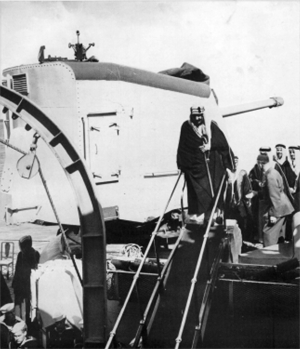 King Ibn Saud comes aboard the U.S.S. Quincy
King Ibn Saud comes aboard the U.S.S. Quincy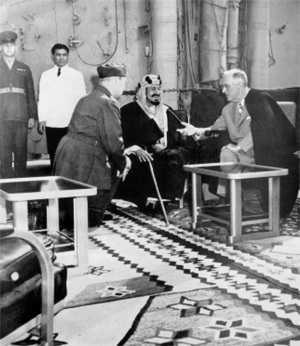 The conference aboard the U.S.S. Quincy 1-r. Colonel Eddy, King Ibn Saud, President RooseveltV. THE CONFERENCE
The conference aboard the U.S.S. Quincy 1-r. Colonel Eddy, King Ibn Saud, President RooseveltV. THE CONFERENCENOTHING HAS BEEN PUBLISHED ABOUT THE Political conversations because nobody who was present has broken his silence. I am now breaking mine.
The King steadfastly refused to use, quote or show his copy of the memorandum of conversation. He regarded the occasion as one where a personal friendship between two heads of state, and between two men, was established. In his simple Arab view, such friendship depends wholly upon good will and good faith. When these died with F.D.R. and were not revived by his successor, they cannot be resurrected by producing a piece of paper. As an Arab guest at the meeting, Ibn Saud initiated no topics.
He waited for his host to propose subjects for serious discussion.
It might be noted in passing that at no time did Ibn Saud even hint at economic or financial aid for Saudi Arabia. He traveled to the meeting seeking friends and not funds, in spite of the fact that, at that date, he had no reason to expect that Arabian oil would be produced in quantity to multiply his national income but, on the contrary, ruled in 1945 over a pastoral land which could not produce enough to feed its population, and a land cut off by war from importing the necessities of life.THE PRESIDENTAfter discussing the progress of the war, and expressing his confidence that Germany would be defeated, F.D.R. stated that he had a serious problem in which he desired the King’s advice and help; namely, the rescue and rehabilitation of the remnant of Jews in Central Europe who had suffered indescribable horrors at the hands of the Nazis: eviction, destruction of their homes, torture and mass-murder. He, F.D.R., felt a personal responsibility and indeed had committed himself to help solve this problem. What could the King suggest?
Ibn Saud’s reply was prompt and laconic: “Give them and their descendants the choicest lands and homes of the Germans who had oppressed them.”
F.D.R. replied that the Jewish survivors have a sentimental desire to settle in Palestine and, quite understandably, would dread remaining in Germany where they might suffer again.
The King said that he had no doubt the Jews have good reason not to trust the Germans, but surely the Allies will destroy Nazi power forever and in their victory will be strong enough to protect Nazi victims. If the Allies do not expect firmly to control future German policy, why fight this costly war? He, Ibn Saud, could not conceive of leaving an enemy in a position to strike back after defeat.
In a few minutes, F.D.R. returned to the attack, saying that he counted on Arab hospitality and on the King’s help in solving the problem of Zionism, but the King repeated: “Make the enemy and the oppressor pay; that is how we Arabs wage war. Amends should be made by the criminal, not by the innocent bystander. What injury have Arabs done to the Jews of Europe? It is the ‘Christian’ Germans who stole their homes and lives. Let the Germans pay.” Once more, F.D.R. returned to the subject, complaining that the King had not helped him at all with his problem, but the King, having lost some patience, did not expound his views again, beyond stating (with a note of irony in his voice) that this over-solicitude for the Germans was incomprehensible to an uneducated bedouin with whom friends get more consideration than enemies. The King’s final remark on the subject was to the effect that it is Arab custom to distribute survivors and victims of battle among the victorious tribes in accordance with their number and their supplies of food and water. In the Allied camp there are fifty countries, among whom Palestine is small, land-poor and has already been assigned more than its quota of European refugees.
THE KINGIbn Saud, in his turn, asked F.D.R. for friendship and support. In the conversation the King never seemed to distinguish between F.D.R. as a person and as President of the U.S.A. To an absolute as well as a benevolent monarch, the Chief and the State are the same.
The King stated that his first desire for his land and his people is independence, for which he depends on Allah. Unlike some other Arab lands, his country had never been occupied nor “protected” as a dependent. Without this independence, he would not and could not seek an honorable friendship, because friendship is possible only with mutual and equal respect. Next to independence, the King said, comes his desire for F.D.R’s friendship because F.D.R. is known as the champion of the Four Freedoms and of every freedom. Furthermore, the King had found that the U.S.A. never colonizes nor enslaves. In very simple language, such as he must often have used in cementing alliances with tribal chiefs, Ibn Saud then asked F.D.R. for friendship.
The President then gave Ibn Saud the double assurance, repeated just one week before his death in his letter to Ibn Saud, dated April 5, 1945: (1) He personally, as president, would never do anything which might prove hostile to the Arabs; and (2) the U.S. Government would make no change in its basic policy in Palestine without full and prior consultation with both Jews and Arabs.* To the King, these oral assurances were equal to an alliance; he did not foresee that Death was waiting in the wings to bear the speaker away before the promises could be redeemed. Now that Mr. Dulles has completed the first goodwill tour ever made by an American Secretary of State to the Near East, Ibn Saud’s son and successor, for long his father’s closest counselor, may again hope that the promise will be revived.
MR. TRUMANThe historic conference had an anticlimax at the White House which has never been reported.
The first week in October, 1945, the Secretary of State recalled four chiefs of U.S. Missions simultaneously to have them testify as a group to Mr. Truman regarding the deterioration of American political interests in the Near East: the U.S. Ministers in Egypt, Lebanon and Syria (jointly), Saudi Arabia, and the Consul-General to mandated Palestine.The four arrived for a White House appointment which had been scheduled for about October 10.
The four were kept idle in Washington four weeks, away from their posts and with no duties whatsoever, because the White House advisors, including David K. Niles, persuaded the President that it would be impolitic to see his Ministers to Arab countries, no matter how briefly, prior to the November Congressional elections.
After the elections, the Director of the Near East Office of the Department of State was allowed to bring the four in for a private conference with Mr. Truman.
The spokesman for the group, George Wadsworth, presented orally an agreed statement in about twenty minutes. There was little discussion and the President asked few questions in the meeting whose Minutes have been carefully guarded in the Department of State. Finally, Mr. Truman summed up his position with the utmost candor: “I’m sorry, gentlemen, but I have to answer to hundreds of thousands who are anxious for the success of Zionism; I do not have hundreds of thousands of Arabs among my constituents.”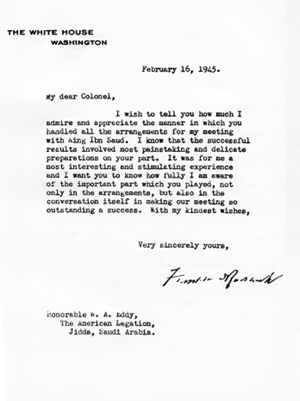
THE WHITE HOUSE
WASHINGTON
February 16, 1945.
My dear Colonel,
I wish to tell you how much I admire and appreciate the manner in which you handled all the arrangements for my meeting with King Ibn Saud. I know that the successful results involved most painstaking and delicate preparations on your part. It was for me a most interesting and stimulating experience and I want you to know how fully I am aware of the important part which you played, not only in the arrangements, but also in the conversation itself in making our meeting so outstanding a success. With my kindest wishes,
Very sincerely yours,
Franklin Roosevelt
Honorable W.A. Eddy,
The American Legation,
Jidda, Saudi Arabia
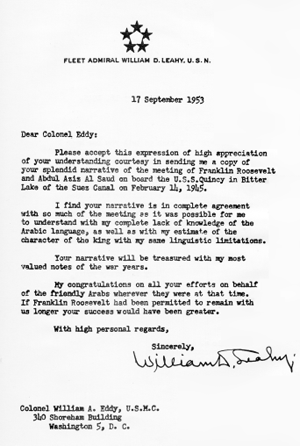
FLEET ADMIRAL WILLIAM D. LEAHY, U.S.N.
17 September 1953
Dear Colonel Eddy:
Please accept this expression of high appreciation of your understanding courtesy in sending me a copy of your splendit narrative of the meeting of Franklin Roosevelt and Abdul Aziz Al Saud on board the U.S.S. Quincy in Bitter Lake of the Suez Canal on February 14, 1945.
I find your narrative is in complete agreement with so much of the meeting as it was possible for me to understand with my complete lack of knowledge of the Arabic language, as well as with my estimate of the character of the king with my same linguistic limitations.
Your narrative will be treasured with my most valued notes of the war years.
My congratulations on all your efforts on behalf of the friendly Arabs wherever they were at that time. If Franklin Roosevelt had been permitted to remain with us longer your success would have been greater.
With high personal regards,
Sincerely,
William D. Leahy, U.S.N.
Colonel William A. Eddy, U.S.M.C.
340 Shoreham Building
Washington 5, D.C.
VI. THE RETURNHAVING TAKEN MY LEAVE OF THE PRESIDENT I WAS asked by his daughter, Mrs. Anna Roosevelt Boettiger, to come below and explain to her the contents of several enormous parcels which had been delivered to the QUINCY addressed to Mrs. Franklin D. Roosevelt and to Mrs. Boettiger. I went down to find a royal parade of gifts on view in a cabin. There were several complete full-dress harim costumes, beautifully embroidered in many colors of silk. Arabian ladies are limited in their opportunities to impress others with these beautiful gowns since they are worn only indoors and seen only by the husband, father, sons, and other ladies. In addition to the harim clothes, the gifts included several vials of rarely tinted glass, others of alabaster, containing the perfumes of Araby, including the favorite of all–attar of roses. Also there were large pieces of uncut amber, the like of whose size I have never seen, from the bottom of the Red Sea. From the eastern coasts of Arabia there were pearl rings, pearl earrings, pearl-studded bracelets and anklets, and belts woven of gold thread with cunning devices, the skill which has reached its highest perfection in Saudi Arabia, the crowning achievement in handiwork of the women of the Hasa.While I was going over the gifts with Mrs. Boettiger, Churchill arrived on board and was with the President when I emerged on deck. The President introduced me to Mr. Churchill and said facetiously, “This is my Minister to Arabia. He has Ibn Saud on one of my destroyers and I haven’t decided yet whether or not you are going to see the King.” Mr. Churchill merely rolled his cigar around between his lips, and grinned confidently.
The principal present from the King to the President, a beautiful diamond-encrusted sword, had not been delivered to me at the airplane in time for me to take to Alexandria. The King, however, directed that it be entrusted to me and that I be made responsible for seeing that it reached Mr. Roosevelt. Late that afternoon the King and his party debarked from the MURPHY into a motorcade of cars provided by the British and drove off to the Fayoum Oasis where he was to meet Churchill. It was a relief to know that my responsibilities were over, without any potentate being assassinated or any miscarriage of the confidential arrangements. To be sure, I was not entirely in the clear because I still had the sword which, fortunately, was in a very plain-looking box and would not therefore especially attract a homicidal thief. The next day General Giles sent a special officer-courier with the sword on a plane going to Algiers where the QUINCY was to anchor briefly.
Thus ends my narrative of this historic meeting. The President returned to Washington to live long enough to make in person one address to Congress in the course of which he said, ad lib, “I learned more [about Palestine and the Near East] by talking with Ibn Saud for five minutes than I could have learned in exchange of two or letters.”*
The King returned to Jidda to a tumultuous welcome from his people who for once were permitted to disregard the Wahhabi Blue laws and to dance in the streets, while school children sang praises of their Prophet and their King. The reappearance of the King in the flesh occasioned an outburst of wild rejoicing since many still were not wholly convinced that he would return.VII. POSTSCRIPTTO THOSE OF US WHO WERE CLOSE TO THE SCENE this meeting was significant for several reasons:
(1) It was a colorful meeting of two very different but equally impressive heads of state, who were spokesmen for East and for West.
(2) The previously isolationist monarch, Ibn Saud, left his country for the first time. Since that day the doors have been swinging open to the previously closed culture of central Arabia.
(3) The guardian of the Holy Places of Islam, and the nearest we have to a successor to the Caliphs, the Defender of the Muslim Faith and of the Holy Cities of three hundred million people, cemented a friendship with the head of a great Western and Christian nation.
The meeting marks the high point of Muslim alliance with the West. This moral alliance, this willingness of the leader of Islam to face West and bind his fortunes to ours, symbolizes a consummation devoutly to be wished in the world today. With Eastern Europe and perhaps Far East Asia lost to us, with Western Europe and Latin America on our side,
there remains a vast tract of land from Morocco to Pakistan and Afghanistan containing several hundred million people, vast resources of manpower, food and oil, and the strategic bases and the warm water ports which would be indispensable to us in a third world war. Yet, since 1945, little has been accomplished officially to bind the Muslims to us while a great deal has been done to alienate them. (4) So far as its effect upon the Near East was concerned, the meeting between Mr. Roosevelt and Ibn Saud found its greatest significance in the fact that for once the United States spoke to the friendly and sovereign governments and peoples of that area with its own voice, in its own name and with its own lips. The insistence of Churchill upon meeting the three monarchs immediately after they had seen Mr. Roosevelt was caused by the anxiety of some of the powers lest the United States deal directly with the peoples of the Near East. The French were equally worried when, at the Casablanca Conference, Mr. Roosevelt insisted on seeing the Sultan of Morocco without being chaperoned by the French Administrator.
The people of the Near East, unlike the colonizing powers, have hoped and longed for direct dealing with the U.S.A. without any intervention of a third party. The habits of the past which led us to regard North Africa and the Near East as preserves of Europe were broken at one blow by Mr. Roosevelt when he met the three kings in the Suez Canal in 1945.
For years our State Department and diplomats, led by Wallace Murray and Loy Henderson, had worked to bring about this direct and friendly approach of one sovereign state to another, with success in Syria and Lebanon, without much success in Iraq, and with no visible results in Egypt and Saudi Arabia. Even as late as 1941 the White House had informed Ibn Saud that Lend-Lease aid to Arabia or loans for public works, though financed by the United States, would be routed through British hands, since Arabia was “remote” from the United States.Today we are in some danger of a return to this policy of tacitly recognizing European spheres of influence in the Near East. Arabs are perplexed to understand why so often we act not directly in line with our own national policies but indirectly and apparently for the benefit of a third party, which is neither the American nor the Arab, but some European power or even Israel.The personal friendship of Mr. Roosevelt with Ibn Saud could not have outlasted their lives in any case. But the great regret in the Near East over the untimely death of our late president is that he was not able to establish as a precedent and perpetuate this policy of direct dealing on the basis of our own mutual interests.
However, the loss of the good will of these millions of Muslims might yet be retrieved by friendly gestures of comradeship and of alliance. Our diplomats, our Point IV program, our Department of Defense, may yet have time to convince the Near East that we place a very real value upon their friendship, their independence of Russia, upon their stability and prosperity, and upon the common front which Islam like Christianity faces in the threat from atheistic Russian imperialism.
It was not so long ago that our travelers in the Far East returned with ridicule of the Chinese armies as composed of half-hearted or chicken-hearted men who carry umbrellas rather than guns into battle and who fight only when the spirit moves them. We do not now ridicule the Chinese soldier in Korea in those terms. Why? Equipment and discipline make all the difference. The Muslim world does not have tanks or atom bombs and is, therefore, often brushed aside as unimportant in the world struggle. Like the Chinese, they also, however, might be united, armed, and disciplined, either for freedom or for tyranny.The United States can still tip the balance one way or the other. If we regard the nations of the world as a string of sixty-odd pearls, we have to admit that the string has been broken and many of the pearls lost. The most precious of all remaining pearls, one which is not firmly within our mutual circle, but which is still within our reach, is the friendship, the good will, and the resources of the three hundred million Muslims of the world. There are those who are bent upon taking this pearl of great price and hurling it to the bottom of the sea. If they succeed in that wanton and disloyal act, let them hope that the American people will some day forgive them; for they know not what they do.
William A. EddyColonel William A. Eddy, U. S. Marine Corps, Retired, is the only person alive who knows exactly what was said between F.D.R. and Ibn Saud, as he was sole interpreter throughout.
He was born in Sidon (Lebanon) in 1896, the son and grandson of Presbyterian missionaries who lived and died in Syria. He received his Litt.B. from Princeton University, 1917; PhD., 1922.Professor of English, American University at Cairo, 1923- 28; Dartmouth College, 1928-1936.
President of Hobart and William Smith Colleges, 1936- 1941.
U.S. Naval Attache, American Legation, Cairo, 1941.
Chief of OSS in North Africa, 1942-43.
First U.S. Minister Plenipotentiary of Saudi Arabia, 1944-1946.Consultant to Arabian-American Oil Co., 1947-1952.
ConsultaHolder of Navy Cross, the Distinguished Service Cross, The Silver Star (2), the Purple Heart (2), The Legion of Merit. Wounded in battle of Belleau Woods, 1918.
_______________
Notes: * “There was not a goodlier person than he; from his shoulders and upward he was higher than any of his people.” (I Samuel IX:2)
*True Magazine, December, 1953; See also Life, March 19, 1945.
* The double promise in this paragraph, contained in the letter from F.D.R. to Ibn Saud, April 5, 1945, is the only part of this conference which has ever been published. See N.Y. Times, October 19, 1945.
* See N.Y. Times, March 2, 1945. In Robert Sherwood’s Roosevelt and Hopkins, Mr. Hopkins conveys the curious impression that President Roosevelt was disappointed in his conferences with Ibn Saud. On the contrary, the President wrote to me, February 16, 1945, that his meeting with Ibn Saud was “so outstanding a success” as well as “a most interesting and stimulating experience.”

